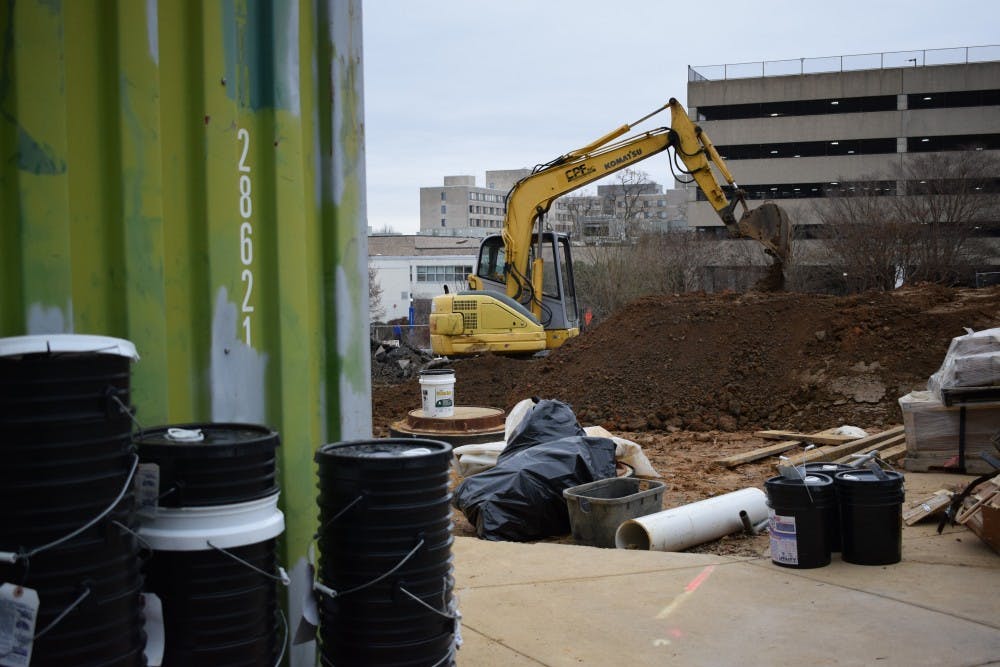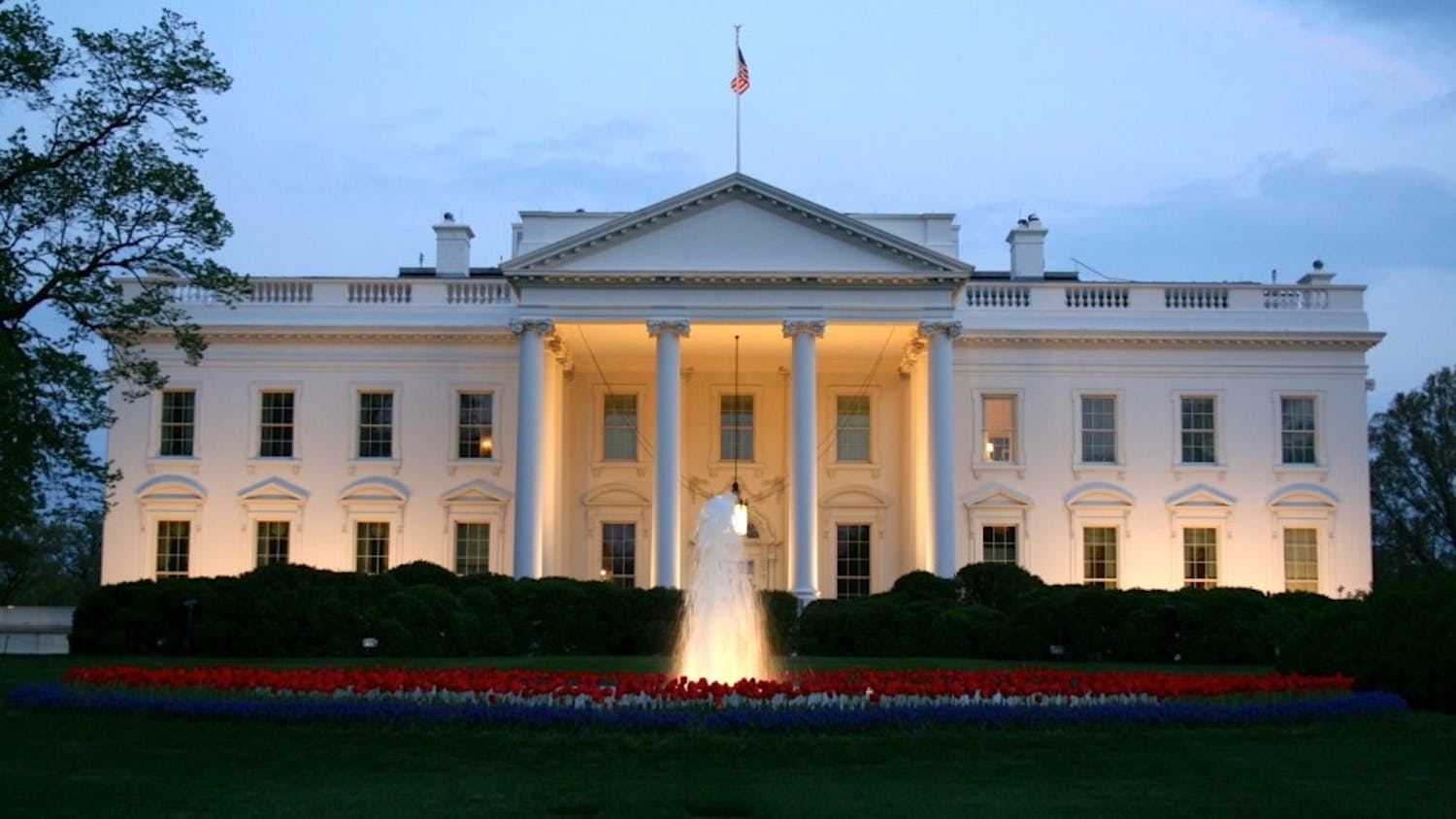Construction workers have been tearing up dirt and laying down pipes on the land and parking lot between the McKinley and Asbury buildings since November. What students and faculty see now is the first phase of a $25 million campus-wide heating renovation project that will make way for the upcoming construction of a new science building across the street from McKinley.
“This is the biggest project we’ve done,” said Doug Fairley, AU’s assistant director for Capital Renewal and Deferred Maintenance, who has worked in Facilities Management at AU for 15 years.
In an April 10 campus-wide memo, David Dower, assistant vice president of planning and management, announced the April 30 start date for the construction of the Hall of Science. The site of the new building is the parking lot area next to the Asbury building, Dower said.
Phase one of the project is “substantially complete,” said Vincent Harkins, the assistant vice president of facilities management. This phase includes laying down the utilities needed to provide low-temperature hot water to the new Hall of Science, Fairley said.
Since the steam lines run through the footprint of the Hall of Science, the heating renovation in the area known as “the Beach” needs to be complete before the building construction begins, Harkins explained.
AU has run on steam for at least six decades now, Fairley said. The switch from a districted steam system – meaning the water travels in the form of steam from a central location – to low-temperature hot water produces savings of $1 million and could reduce AU’s carbon footprint by 5,000 metric tons annually, Fairley said.
The low-temperature hot water system is also a lot safer than steam, which reaches a higher temperature and carries an increased risk of burning, Fairley said.
Phase two of the project will begin in mid-April with the installation of new low-temperature hot water pipes on South Campus. Fairley identified the Mary Graydon Center and Bender Arena as the starting line. His team plans to get the system into Anderson and Letts Halls by fall 2018.
To replace all the steam lines, facilities will have to make tunnels into Anderson Hall. Though this project requires a lot of effort, labor and money, the new pipes will last about 40 years, Fairley said.
Students and faculty members can also expect to see more disruptions in sidewalks and roadways, Fairley said. While facilities will be using current entrances of the campus buildings, all buildings will remain accessible, and facilities will build temporary ramps for disability entrances.
“We’ll obviously make it work, but I think it will definitely be inconvenient,” said freshman Sophie Nowak, who lives in the south side residence halls.
Both Nowak and freshman Jessica Bach said that they were glad to see AU build a new science building and update facilities. However, Bach has already had negative experiences regarding the construction.
“At the start of the semester, I had a beautiful view of green grass and bright flowers outside of my fourth-floor dorm room in Anderson,” Bach said. “Now, every morning starting nearly at 6 a.m., I am awoken to the sounds of drilling and power tools.”
How AU has communicated about construction efforts
Bach said she wishes AU would have better informed students how long the construction would last, especially when it interferes with students’ daily lives.
Facilities Management has announced this disruptive road work for the past two years at the monthly Administrative Operations meetings, attended by every department on campus, including the Office of Campus Life, the provost’s office and Housing and Residence Life, Harkins said.
If students do not hear from these departments, Facilities Management also sends out community-wide emails to announce these types of project, Harkins said. In addition to Dower’s email about the construction of the Hall of Science, Harkins sent a memo on March 29 that included a map of areas affected by the two-year heating renovation project.
Similarly, a parking alert was issued on March 26 announcing the closure of the Asbury parking lot so the space would be available for construction vehicles.
“The LTHW [low temperature hot water] and upcoming Hall of Science projects are expected to severely impact campus parking and traffic over the next couple years,” the email from Parking and Traffic Services said. “Your patience and understanding as American University continues to grow and improve the campus experience is greatly appreciated.”
Prior to Dower’s April 10 announcement, several students said they were unaware that the new Hall of Science was in the works. Rachel Stewart, a senior physics major, said she did not have “any knowledge” about the new building.
“I actually haven't heard too much about it,” senior mathematics major Jacqueline Adams said. “It’s good to see the sciences get some attention.”
Students can look out for emails from the dean of the College of Arts and Sciences and the vice president for development and alumni relations for more information about what this new building means for the community, Dower said.
Hall of Science should be ready by July 2020, officials say
Construction for the Hall of Science will run concurrently with the low-temperature hot water project, Fairley said.
Phase three of the heating renovation project will install the pipes near Hughes, McDowell and Cassell residence halls with construction starting in spring 2019 and ending in fall 2019. North campus will run on steam this winter, but both sides of campus will have low-temperature hot water by the next calendar year, Fairley said.
The phases are planned this way so that construction of the Hall of Science can happen as smoothly as possible, without any interference from utilities replacement, Fairley added. AU students and faculty can expect the campus to be running on low-temperature hot water by late 2019, and the above-ground achievement – the Hall of Science – should be ready for use by July 2020, both Fairley and Dower told The Eagle.
However, the completion dates are subject to change due to engineering delays or pushback from neighbors, Fairley said. AU facilities has had a history of tension with neighbors regarding noise and disruption of views, he said.
In fact, facilities flew balloons to signify how tall the new Hall of Science would be. Neighbors approved, as the balloons were hidden by blooming trees.
Dower assured neighbors in an April 2 on-campus pre-construction meeting that the Hall of Science would diverge significantly from the highly-contested East Campus construction. At the meeting, the six attendees asked Dower about truck routes and construction parking.
“You don’t need to worry about [that],” Dower said after a community member suggested compiling a public log of complaints. “It’s our job.”





